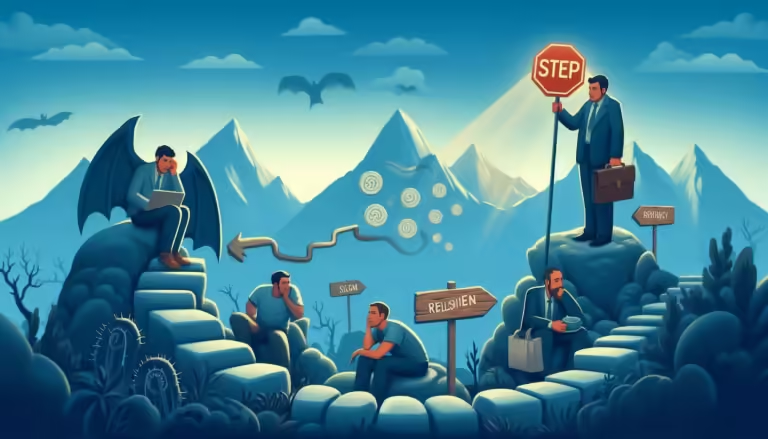What are Common Sales Misconceptions?


1. "Sales Is All About Talking"
What It Is:
Many believe that being a salesperson means being a fast-talking persuader. This misconception assumes that the best salespeople dominate conversations to push their products.
Why It’s Important:
Sales isn’t about who speaks the most but who listens the best. According to a study by Gong.io, top-performing salespeople talk only 43% of the time during sales calls and spend 57% listening.
How to Do It:
- Develop Active Listening Skills: Show genuine interest in what the customer is saying.
- Pause Before Responding: Let the prospect finish speaking fully before responding.
Expert Insight:
“Great salespeople are empathetic listeners, not aggressive talkers. Listening allows you to understand what the client truly needs.”—Daniel Pink, Author of To Sell is Human.
Case Study:
When Sarah Johnson, a sales executive at HubSpot, switched from pitching to listening during her sales calls, her close rate increased by 35%. She started every call with: “Tell me about the biggest challenge you’re facing right now.” Her clients felt heard, and her solutions matched their exact needs.
2. "You Must Always Close the Sale"
What It Is:
Some believe that every sales conversation must end with a deal, or it’s a failure.
Why It’s Important:
Focusing only on closing can damage trust. Research by LinkedIn Sales Solutions found that 88% of buyers are more likely to engage with salespeople who are seen as trusted advisors, not just deal-closers.
How to Do It:
- Adopt a Consultative Approach: Aim to educate and support the buyer rather than force a decision.
- Recognize the Buyer’s Journey: Understand whether your prospect is in the awareness, consideration, or decision phase.
- Follow Up Respectfully: If the timing isn’t right, keep the relationship alive through value-driven follow-ups.
Expert Insight:
“Not every lead is ready to buy today. Your job is to build trust so they come to you when they’re ready.”—Jill Rowley, Sales Enablement Evangelist.
Case Study:
At Salesforce, the team implemented a strategy of nurturing leads over time rather than rushing them. As a result, the company increased its lead conversion rate by 26%, proving that patience pays.
3. "Lower Prices Seal the Deal"
What It Is:
Their is a common belief that offering the lowest price is the fastest way to win customers and sell your product/service with ease.
Why It’s Important:
Price isn’t the only factor buyers consider. According to McKinsey, 70% of B2B customers base their decision on the value and trust provided by the salesperson rather than just the price.
How to Do It:
- Focus on Value: Highlight how your product or service solves a problem better than competitors.
- Use Social Proof: Share testimonials or success stories from similar clients.
- Offer Tiered Solutions: Give customers options based on their budget and needs.
Expert Insight:
“Competing on price alone is itself a race to the bottom. Instead, show how your solution delivers ROI.”—Barbara Corcoran, Investor on Shark Tank.
Case Study:
When Dropbox first launched, they focused on the ease of use and security of their platform rather than competing with free alternatives. Their focus on value helped them secure over 700 million users.
4. "Sales Is Just About Selling Products"
What It Is:
The misconception here is that salespeople should only care about selling their product, not building relationships or helping customers succeed.
Why It’s Important:
Modern sales focus on relationship-building. The Edelman Trust Barometer reveals that 81% of customers won’t buy unless they trust the company.
How to Do It:
- Prioritize Relationship Building: Regularly check in with clients without pitching.
- Provide Continuous Value: Share resources, insights, or tools that help them succeed.
- Become an Industry Expert: Position yourself as someone who understands your industry deeply.
Expert Insight:
“Sales isn’t about closing deals. It’s about opening the relationships that last.”—Jeffrey Gitomer, Author of The Little Red Book of Selling.
Case Study:
John Miller, a senior sales rep at LinkedIn, used a strategy where he shared weekly market reports with his prospects without asking for anything in return. When these prospects were ready to buy, he was their first call, leading to a 40% increase in sales
5. "Cold Calling Is Dead"
What It Is:
With the rise of digital marketing and social selling, many believe that cold calling is obsolete.
Why It’s Important:
Cold calling remains effective when done correctly. Study Conducted by Rain Group, They found that 82% of buyers accept meetings when sellers reach out proactively.
How to Do It:
- Research Before Calling: Personalize your approach by understanding the prospect’s industry and challenges.
- Be Direct and Concise: Start with a strong value proposition.
- Follow a Multi-Channel Approach: Combine calls with emails and LinkedIn outreach.
Expert Insight:
“Cold calling isn’t dead; bad cold calling is. Be smart, be relevant, and you’ll get results.”—Grant Cardone, Sales Trainer and CEO of Cardone Enterprises.
Case Study:
ZoomInfo revamped its cold-calling scripts to focus on value and personalization. As a result, they achieved a 20% higher response rate compared to generic pitches.
6. "Salespeople Are Born, Not Made"
What It Is:
Some believe you need to have a natural talent for selling, and no amount of training can make someone good at it.
Why It’s Important:
Sales is a skill that can be developed. A study by Sales Performance International found that companies providing structured training saw a 50% increase in sales performance.
How to Do It:
- Invest in Training: Take courses on negotiation, communication, and persuasion.
- Learn from Mentors: Shadow experienced salespeople to learn techniques.
- Practice, Practice, Practice: Regularly rehearse sales conversations to refine your approach.
Expert Insight:
“Anyone can learn How to sell if they’re willing to work at it. It’s not about charm; it’s about discipline.”—Zig Ziglar, Renowned Motivational Speaker.
Case Study:
Patricia Gomez, now VP of Sales at Microsoft, started her career as a software engineer with no sales experience. Through rigorous training and mentorship, she developed her skills and became one of the top performers in her field.
7. "Sales Is About Manipulating People"
What It Is:
Some think salespeople are manipulators who pressure or deceive customers into buying. This belief stems from stereotypes of “sleazy” sales tactics often seen in movies or outdated practices.
Why It’s Important:
Manipulation erodes trust and leads to buyer’s remorse. In today’s sales environment, customers are informed and empowered, making honesty and transparency essential for long-term success. According to Edelman, 81% of customers buy only from brands they trust.
How to Do It:
- Be Honest About Limitations: If your product or service isn’t a fit, be upfront.
- Focus on Collaboration: Frame sales conversations as problem-solving sessions, not persuasion battles.
- Seek Win-Win Outcomes: Ensure the solution benefits both you and the client.
Case Study:
At Zappos, the sales team is trained to prioritize customer satisfaction over immediate sales. This includes recommending competitors if they can better meet the customer’s needs. This honesty builds trust, leading to higher lifetime customer value and loyalty.
8. "Introverts Can’t Succeed in Sales"
What It Is:
A widespread misconception is that only outgoing, extroverted people can thrive in sales. This myth suggests introverts lack the charisma or energy needed to close deals.
Why It’s Important:
Introverts often excel in sales because they’re natural listeners, observant, and thoughtful in their approach. Research by Wharton School professor Adam Grant reveals that ambiverts (those who balance introvert and extrovert traits) are the most effective salespeople.
How to Do It:
- Leverage Your Strengths: Use your listening and observation skills to deeply understand customer needs.
- Prepare Thoroughly: Introverts often shine when they’re well-prepared, so research prospects and plan your conversations.
- Use Written Communication: If verbal pitches feel daunting, supplement them with well-crafted emails or proposals.
Case Study:
Susan Cain, author of Quiet: The Power of Introverts in a World That Can’t Stop Talking, highlights how introverted sales professional James Blake at Oracle used his calm, deliberate approach to close deals. Instead of flashy presentations, he focused on client needs and outperformed his extroverted peers.
9. "Rejection Means Failure"
What It Is:
Many salespeople equate rejection with personal or professional failure. This misconception creates fear and hinders persistence, leading to fewer opportunities.
Why It’s Important:
Rejection is a normal part of sales. Studies by Salesforce show that top-performing reps view rejection as feedback, not failure.
How to Do It:
- Reframe Rejection: See it as a learning opportunity rather than a personal critique.
- Ask for Feedback: When a deal falls through, ask the prospect what didn’t work for them.
- Keep the Door Open: Maintain a positive relationship even if they say no; circumstances may change in the future.
Expert Insight:
“Every ‘no’ gets you closer to a ‘yes.’ Rejection is part of the process, not the end of it.”—Brian Tracy, Sales Trainer and Author.
Case Study:
When Barbara Smith, a new rep at Shopify, faced a 70% rejection rate in her first quarter, she began tracking feedback from every failed pitch. Within six months, she adjusted her approach and improved her close rate by 45%.
10. "Technology Replaces Personal Connections in Sales"
What It Is:
With the rise of CRM tools, chatbots, and automated emails, some believe technology is replacing the need for human interaction in sales.
Why It’s Important:
Technology enhances, but doesn’t replace, human connections. Gartner research shows that 82% of B2B buyers still want human interaction, especially during the final stages of their decision-making process.
How to Do It:
- Use Technology to Enhance, Not Replace: Automate repetitive tasks like data entry, but keep personal touchpoints for high-value interactions.
- Personalize Communication: Leverage CRM data to tailor your messages to the prospect’s preferences and pain points.
- Stay Accessible: Use technology to make yourself easier to reach, not harder.
Expert Insight:
“Tech tools should support your relationships, not replace them. Sales will always be a people business.”—Mary Shea, Principal Analyst at Forrester.
Case Study:
HubSpot equips its reps with advanced CRM tools but emphasizes personalized follow-ups and meaningful client conversations. This hybrid approach led to a 23% increase in customer satisfaction scores in 2023.
Conclusion : What are the Common Sales Misconception
FAQs
The biggest misconception is that sales is about “talking a lot.” In reality, listening and understanding the customer’s needs are far more important than just pitching.
No. Sales is about solving problems and helping customers find the best solutions, even if it means guiding them to a competitor.
Not at all. Introverts can be excellent salespeople because they listen well, prepare thoroughly, and build meaningful relationships.
No, cold calling still works when done right. A personalized and thoughtful approach can make cold calls successful in building initial connections.
No. Customers value quality, trust, and the ability to solve their problems over price alone. Competing on price alone can hurt your business.
No, rejection is normal in sales. Every rejection is a learning opportunity to improve your approach or timing.
No. Technology helps with efficiency, but people still value human interaction, especially in building trust and making decisions.
No. Successful sales are built on trust, transparency, and finding solutions—not manipulation or trickery.
No. Great salespeople focus on building long-term relationships, understanding customer needs, and providing value, not just on closing deals.
Anyone can learn sales. It’s a skill that improves with practice, training, and experience, not something you have to be born with.
Share this post




Chiranjeev Jaiswal
Chiranjeev Jaiswal (M.B.A. and P.G.D.M.in Marketing from IM-BHU) launched "Vibrant Marketer" out of a deep passion for all things marketing. After years of working in the industry, he realized that marketing success isn’t about following the same playbook—it’s about staying ahead of the curve and thinking outside the box.












